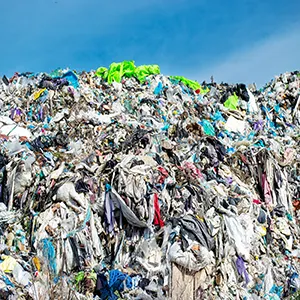
Donating clothes to charity has a dark side, and it will surprise you
That pile of shirts you just dropped off at the charity shop? There’s something you should know about where those donated clothes are really going.
Most of us grew up believing a simple story. You clean out your closet, drop off the clothes you don’t wear anymore at a donation center, and someone who needs them gets to use them.
It feels good. It seems responsible.
But the truth about what happens to our old clothes is far more complicated – and, frankly, troubling.
Dirty secret of donated clothes
Here’s what actually happens when you donate clothes. First, they go to charity shops and collectors who sort through everything. The nicest pieces might be sold at the local thrift store.
But there’s a catch: these organizations receive far more clothing than they can sell. We’re talking about mountains of fabric that no one locally wants to buy.
So what happens to the rest? Some items are thrown away. But a huge portion gets packed into bales and shipped overseas.
The clothes leave the country, which makes our waste figures look better, but the problem doesn’t disappear. It just moves.
A study in Nature Cities tracked clothing donations in nine wealthy cities, including Austin, Toronto, Melbourne, and Oslo.
The pattern was the same everywhere: too many clothes coming in, not enough local demand, and massive exports to other countries.
In Norway, almost all collected used clothing leaves the country. The U.S. and Australia ship out huge amounts, too.
Donated clothes and charities
The charity organizations we rely on are overwhelmed by donations. They were never built to handle this volume of clothing, and they weren’t designed to be waste-management systems.
“We’re used to charities doing the heavy lifting, but they’ve been unable to fully handle the volume of donated clothes for a long time now,” explained Dr. Yassie Samie of RMIT University in Melbourne.
“Charities are driven by social welfare values and need to raise funds for their programs. However, their operations are ill-equipped to deal with the volume of used textiles that need to be reused and recycled.”
Think about the scale here. Global textile waste adds up to tens of millions of tons every year. Much of that starts in wealthy cities where people buy clothes constantly and get rid of them just as fast.

The real problem runs deeper
Two words explain why this keeps happening: overconsumption and oversupply. Clothes have gotten incredibly cheap. We buy more than ever before, wear things just a few times, and then toss them.
The quality is often so poor that items can’t survive being passed between multiple owners or recycled into something new.
Even the best-run charity can’t transform low-quality fast fashion into endless reuse opportunities.
When these cheap clothes flood secondhand markets, they actually hurt small resale businesses. Some thrift stores import higher-quality used clothing because local donations are often unwearable.
The researchers introduced an important concept called “sufficiency.” It’s not just about recycling or reusing clothes better – it’s about buying less stuff in the first place.
They compare trying to create a circular economy without sufficiency to bailing water out of a boat without fixing the hole.
If companies keep churning out cheap clothes and we keep treating them like they’re disposable, no amount of recycling will solve the problem.
Changes at the city-level
The study doesn’t just point out problems – it offers solutions. Cities need to stop treating textiles as a charity issue and start treating them as waste that needs proper management.
That means setting up real systems for collecting, sorting, and processing old clothes locally instead of shipping them away.
Cities can also make it easier for people to repair and reuse what they already own. Some places lend out sewing machines at libraries. Others host swap events or teach basic mending skills.
When cities offer discounted repair services for people who can’t afford full price, more clothes stay in use longer.
Advertising is also a problem. Fast fashion companies dominate billboards, storefronts, and social media.
The researchers suggest cities should limit fashion advertising in public spaces and give that visibility to thrift stores, repair shops, and clothing swaps instead.
“Sustainable fashion initiatives, like second-hand retailers, struggle to compete with fashion brands’ big marketing budgets and convenient locations,” Dr. Samie noted.
“Fast fashion alternatives exist but they are under-promoted, despite their potential to significantly reduce cities’ textile waste.”
Urban planning plays a role, too. When cities keep building huge malls while pushing repair cafés and resale shops to the edges of town, they’re basically designing a system where fast fashion wins.
Some European cities are already changing this by offering cheaper rent and grants to businesses focused on reuse and repair.
Actions that individuals can take
For regular people, the message is pretty clear. The most impactful thing you can do is slow down how often you buy and toss clothes.
Wear what you own more often. Fix things when they break. When you do buy something new, choose quality that will last.
Support local thrift stores, repair shops, and clothing swaps in your area. These businesses and community groups need customers to survive and grow. The more we use them, the stronger the whole system becomes.
The next time you’re about to donate a bag of clothes, remember this: donating isn’t a magic solution that makes overconsumption okay.
Those clothes might travel thousands of miles and still end up in a landfill, just in a different country. The real solution starts with buying less and using what we have for far longer than we currently do.
Wealthy cities have both the responsibility and the tools to act. But even the best systems won’t work if we keep treating clothes as disposable.
The change has to happen at every level – from how companies make clothes to how cities manage them to how each of us shops and cares for what we own.
The full study was published in the journal Nature Cities.
—–
Like what you read? Subscribe to our newsletter for engaging articles, exclusive content, and the latest updates.
Check us out on EarthSnap, a free app brought to you by Eric Ralls and Earth.com.
—–













